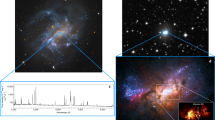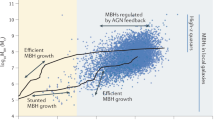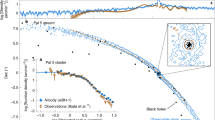Abstract
Supermassive black holes are now thought to lie at the heart of every giant galaxy with a spheroidal component, including our own Milky Way1,2. The birth and growth of the first ‘seed’ black holes in the earlier Universe, however, is observationally unconstrained3 and we are only beginning to piece together a scenario for their subsequent evolution4. Here we report that the nearby dwarf starburst galaxy Henize 2-10 (refs 5 and 6) contains a compact radio source at the dynamical centre of the galaxy that is spatially coincident with a hard X-ray source. From these observations, we conclude that Henize 2-10 harbours an actively accreting central black hole with a mass of approximately one million solar masses. This nearby dwarf galaxy, simultaneously hosting a massive black hole and an extreme burst of star formation, is analogous in many ways to galaxies in the infant Universe during the early stages of black-hole growth and galaxy mass assembly. Our results confirm that nearby star-forming dwarf galaxies can indeed form massive black holes, and that by implication so can their primordial counterparts. Moreover, the lack of a substantial spheroidal component in Henize 2-10 indicates that supermassive black-hole growth may precede the build-up of galaxy spheroids.
This is a preview of subscription content, access via your institution
Access options
Subscribe to this journal
Receive 51 print issues and online access
$199.00 per year
only $3.90 per issue
Buy this article
- Purchase on Springer Link
- Instant access to full article PDF
Prices may be subject to local taxes which are calculated during checkout



Similar content being viewed by others
References
Magorrian, J. et al. The demography of massive dark objects in galaxy centers. Astron. J. 115, 2285–2305 (1998)
Ghez, A. M. et al. Stellar orbits around the galactic center black hole. Astrophys. J. 620, 744–757 (2005)
Volonteri, M. Formation of supermassive black holes. Astron. Astrophys. Rev. 18, 279–315 (2010)
Heckman, T. The co-evolution of galaxies and black holes: current status and future prospects. IAU Symp. 267, 3–14 (2010)
Allen, D. A., Wright, A. E. & Goss, W. M. The dwarf emission galaxy He2–10. Mon. Not. R. Astron. Soc. 177, 91–97 (1976)
Johnson, K. E., Leitherer, C., Vacca, W. D. & Conti, P. S. Hubble Space Telescope observations of HE 2–10: outflows and young super-star clusters. Astron. J. 120, 1273–1288 (2000)
Kobulnicky, H. A., Dickey, J. M., Sargent, A. I., Hogg, D. E. & Conti, P. S. Aperture synthesis observations of molecular and atomic gas in the Wolf-Rayet starburst galaxy Henize 2–10. Astron. J. 110, 116–130 (1995)
Méndez, D. I. et al. A complex bipolar outflow in the Wolf-Rayet BCDG He 2–10. Astron. Astrophys. 349, 801–811 (1999)
Johnson, K. E. & Kobulnicky, H. A. The spectral energy distributions of infant super-star clusters in Henize 2–10 from 7 millimeters to 6 centimeters. Astrophys. J. 597, 923–928 (2003)
Kobulnicky, H. A. & Martin, C. L. The diffuse and compact X-ray components of the starburst galaxy Henize 2–10. Astrophys. J. 718, 724–738 (2010)
Engelbracht, C. W. et al. Metallicity effects on mid-infrared colors and the 8 μm PAH emission in galaxies. Astrophys. J. 628, L29–L32 (2005)
Calzetti, D. et al. The calibration of mid-infrared star formation rate indicators. Astrophys. J. 666, 870–895 (2007)
Whitney, B. A. et al. Spitzer Sage Survey of the Large Magellanic Cloud. III. Star formation and ∼1000 new candidate young stellar objects. Astron. J. 136, 18–43 (2008)
Skrutskie, M. F. et al. The Two Micron All Sky Survey (2MASS). Astron. J. 131, 1163–1183 (2006)
Bell, E. F., McIntosh, D. H., Katz, N. & Weinberg, M. D. The optical and near-infrared properties of galaxies. I. Luminosity and stellar mass functions. Astrophys. J. 149 (Supp.). 289–312 (2003)
van der Marel, R. P., Roeland, P., Alves, D. R., Hardy, E. & Suntzeff, N. B. New understanding of Large Magellanic Cloud structure, dynamics, and orbit from carbon star kinematics. Astron. J. 124, 2639–2663 (2002)
Kim, S. et al. Aperture synthesis mosaic of the Large Magellanic Cloud. Astrophys. J. 503, 674–688 (1998)
Reines, A. E., Johnson, K. E. & Goss, W. M. Emerging massive star clusters revealed: high-resolution imaging of NGC 4449 from the radio to the ultraviolet. Astron. J. 135, 2222–2239 (2008)
Reines, A. E., Johnson, K. E. & Hunt, L. K. A new view of the super star clusters in the low-metallicity galaxy SBS 0335–052. Astron. J. 136, 1415–1426 (2008)
Reines, A. E., Nidever, D. L., Whelan, D. G. & Johnson, K. E. The importance of nebular continuum and line emission in observations of young massive star clusters. Astrophys. J. 708, 26–37 (2010)
Ho, L. C. Nuclear activity in nearby galaxies. Annu. Rev. Astron. Astrophys. 46, 475–539 (2008)
Henry, A. L., Turner, J. L., Beck, S. C., Crosthwaite, L. P. & Meier, D. S. Brackett lines from the super star cluster nebulae in HE 2–10. Astron. J. 133, 757–767 (2007)
Ulvestad, J. S., Johnson, K. E. & Neff, S. G. A. VLBI search for radio supernovae in Wolf-Rayet Galaxies. Astron. J. 133, 1868–1873 (2007)
Orienti, M. & Prieto, M. A. Radio structures of the nuclei of nearby Seyfert galaxies and the nature of the missing diffuse emission. Mon. Not. R. Astron. Soc. 401, 2599–2610 (2010)
Merloni, A., Heinz, S. & di Matteo, T. A fundamental plane of black hole activity. Mon. Not. R. Astron. Soc. 345, 1057–1076 (2003)
Filippenko, A. V. & Sargent, W. L. W. Discovery of an extremely low luminosity Seyfert nucleus in the dwarf galaxy NGC 4395. Astrophys. J. 342, L11–L14 (1989)
Barth, A. J., Ho, L. C., Rutledge, R. E. & Sargent, W. L. W. POX 52: a dwarf Seyfert 1 galaxy with an intermediate-mass black hole. Astrophys. J. 607, 90–102 (2004)
Greene, J. E. & Ho, L. C. A new sample of low-mass black holes in active galaxies. Astrophys. J. 670, 92–104 (2007)
Barth, A. J., Greene, J. E. & Ho, L. C. Low-mass Seyfert 2 galaxies in the Sloan Digital Sky Survey. Astron. J. 136, 1179–1200 (2008)
Greene, J., Ho, L. C. & Barth, A. J. Black holes in pseudobulges and spheroidals: a change in the black hole-bulge scaling relations at low mass. Astrophys. J. 688, 159–179 (2008)
Acknowledgements
A.E.R. is grateful for many discussions on this work, in particular with M. Whittle, J. Ulvestad, M. Goss, S. Kannappan, J. Greene, R. Hickox, A. Evens, R. O’Connell, R. Chevalier, A. Seth, E. Gallo, S. Ransom, L. Hunt and J. Simon. A.E.R. acknowledges support from a NASA Earth and Space Science Fellowship, and the University of Virginia through a Governor’s Fellowship and a Dissertation Acceleration Fellowship. G.R.S. acknowledges support for this work by NASA through the Chandra X-ray Observatory Center, which is operated by the Smithsonian Astrophysical Observatory for and on behalf of NASA. K.E.J. acknowledges support from the NSF through a CAREER award and the David and Lucile Packard Foundation through a Packard Fellowship. Support was provided by NASA through a grant from the Space Telescope Science Institute, which is operated by the Association of Universities for Research in Astronomy, Inc. The National Radio Astronomy Observatory is a facility of the National Science Foundation operated under cooperative agreement by Associated Universities, Inc. This research has made use of data obtained from the Hubble Space Telescope and Chandra X-ray Observatory Data Archives.
Author information
Authors and Affiliations
Contributions
A.E.R. reduced the HST/NICMOS images, synthesized the multi-wavelength data, and led the analysis, interpretation, and writing of the paper. G.R.S. analysed the Chandra data, and helped with the interpretation and writing of the paper. K.E.J. led the HST/NICMOS and VLA proposals. K.E.J. and C.L.B. reduced and analysed the VLA data. All authors discussed the results and presentation of the paper.
Corresponding author
Ethics declarations
Competing interests
The authors declare no competing financial interests.
Supplementary information
Supplementary Information
The file contains Supplementary Data, Supplementary Table 1, Supplementary Figure 1 with a legend and additional references. (PDF 238 kb)
Rights and permissions
About this article
Cite this article
Reines, A., Sivakoff, G., Johnson, K. et al. An actively accreting massive black hole in the dwarf starburst galaxy Henize 2-10. Nature 470, 66–68 (2011). https://doi.org/10.1038/nature09724
Received:
Accepted:
Published:
Issue Date:
DOI: https://doi.org/10.1038/nature09724
This article is cited by
-
Black-hole-triggered star formation in the dwarf galaxy Henize 2-10
Nature (2022)
-
Hunting for massive black holes in dwarf galaxies
Nature Astronomy (2022)
-
Cosmological simulations of galaxy formation
Nature Reviews Physics (2020)
-
Nuclear star clusters
The Astronomy and Astrophysics Review (2020)
-
An X-ray detection of star formation in a highly magnified giant arc
Nature Astronomy (2019)
Comments
By submitting a comment you agree to abide by our Terms and Community Guidelines. If you find something abusive or that does not comply with our terms or guidelines please flag it as inappropriate.



